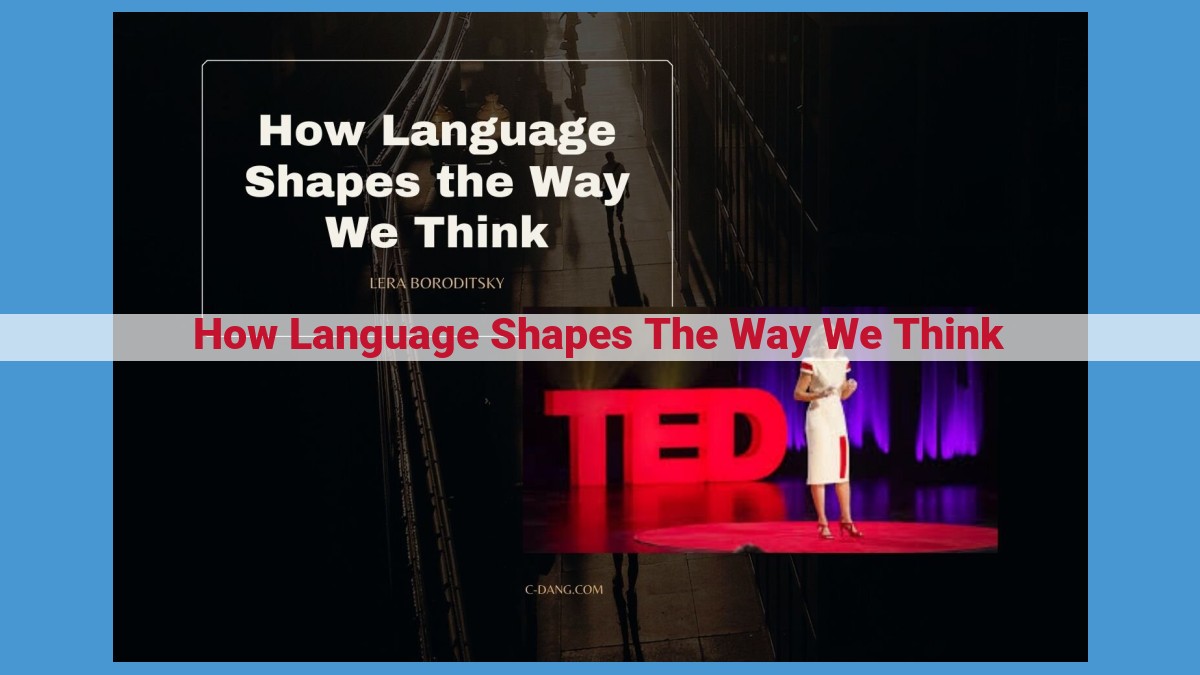Language significantly influences how we perceive and think about the world. The Sapir-Whorf hypothesis proposes that language determines our thoughts, while cognitive linguistics explores the connection between language, cognition, and embodiment. Cultural linguistics examines the interplay between language and culture, revealing how different languages encode distinct ways of thinking. Understanding the language-thought relationship highlights language’s profound impact on cognition and worldview.
Linguistic Relativity: The Sapir-Whorf Hypothesis
Concept of Linguistic Relativity
Imagine a world where the color blue doesn’t exist. Surprising, right? But for speakers of the Himba tribe in Namibia, this is their reality. The Himba use the same word for both “green” and “blue,” indicating that their perception of these colors differs from our own.
This is the essence of linguistic relativity: the idea that language influences how we perceive reality. In other words, the language we speak shapes the way we think, experience the world, and categorize our thoughts.
Sapir-Whorf Hypothesis
The most extreme version of linguistic relativity is the Sapir-Whorf Hypothesis, proposed by renowned linguists Edward Sapir and Benjamin Lee Whorf. They argued that language not only influences perception but determines our thoughts.
According to this hypothesis, people from different linguistic backgrounds have fundamentally different worldviews because their languages encode distinct ways of categorizing experiences. For example, the Inuit language has several words for different types of snow, reflecting their dependence on snow for survival. This, Whorf argued, gives the Inuit a more nuanced understanding of snow conditions than English speakers.
However, the strong version of the Sapir-Whorf Hypothesis has been heavily criticized. Empirical studies have shown that while language can certainly influence our perception, it does not entirely determine our thoughts. We can still understand and think about concepts that are not explicitly represented in our native language.
Nevertheless, linguistic relativity remains a fascinating and important concept, highlighting the profound connection between language and cognition.
Cognitive Linguistics: Exploring the Mind-Language Connection
Cognitive linguistics delves into the intricate relationship between language, cognition, and the body. This field of study recognizes that language is not merely a tool for communication, but also a fundamental shaper of our thoughts and experiences.
Embodied Cognition: Grounding Thoughts in Physicality
One key concept in cognitive linguistics is embodied cognition. This theory posits that our physical experiences, such as bodily sensations and movements, play a crucial role in shaping our cognitive abilities. Our language, in turn, reflects these embodied experiences. For instance, we often metaphorically refer to abstract concepts in terms of physical actions, like “grasping” an idea or “weighing” a decision.
Conceptual Metaphor Theory: Constructing Abstract Thought
Conceptual metaphor theory sheds light on how we use metaphors to structure abstract thought. According to this theory, language provides us with a framework of conceptual metaphors that we use to understand and reason about the world. These metaphors are deeply ingrained in our language and culture, shaping our perception of reality. For example, the metaphor of “love as a journey” influences our understanding of relationships as having a beginning, middle, and end.
Frame Semantics: Framing Perception through Language
Frame semantics explores how language frames our perception of the world. Frames are structured representations of knowledge that organize our thoughts and experiences. They provide us with a set of default assumptions and expectations about how things work. Language plays a pivotal role in activating and shaping these frames, influencing our interpretation of events and situations.
Cognitive linguistics offers valuable insights into the profound interplay between language, thought, and the human experience. By understanding these connections, we gain a deeper appreciation for the power of language in shaping our cognitive abilities, cultural values, and worldview.
Cultural Linguistics: The Interplay of Language and Culture
Embark on a linguistic adventure as we explore cultural linguistics, a realm where language and culture intertwine like intricate threads in a tapestry. It’s a fascinating field that illuminates how language isn’t merely a tool for communication but a mirror reflecting society’s values, beliefs, and experiences.
Language is like a prism, through which we perceive and interact with the world. It shapes our cognition, influencing not only how we express thoughts but also how we think about them. Cultural linguistics delves into this intricate relationship, revealing how language embodies the unique cultural fabric of communities.
One striking example lies in the way different languages encode concepts like time, space, and relationships. In some cultures, time is perceived as linear and unidirectional, while others envision it as cyclical and fluid. Similarly, the concept of space can vary, with some languages having multiple words for different types of spatial relations. These linguistic nuances reflect deep-seated cultural differences in how we perceive and navigate our surroundings.
Language also acts as a conduit for transmitting cultural values and beliefs. Proverbs, idioms, and folk tales are linguistic vessels that carry the wisdom and collective experiences of generations. Through these linguistic expressions, we gain insights into the moral compass, social norms, and historical events that have shaped a particular culture.
Furthermore, language can influence our perception of relationships and social dynamics. In some languages, there are specific terms for different kinship relations, such as “uncle” or “cousin.” These linguistic distinctions reflect the intricate social structures and interpersonal relationships within that culture. Conversely, the absence of certain kinship terms in other languages suggests a different way of conceptualizing family and social bonds.
In the tapestry of cultural linguistics, language and culture are inseparable strands, each shaping and reflecting the other. By unraveling these linguistic threads, we gain a deeper understanding of the rich diversity of human thought, the interconnectedness of societies, and the profound influence language wields in shaping our worldviews.
